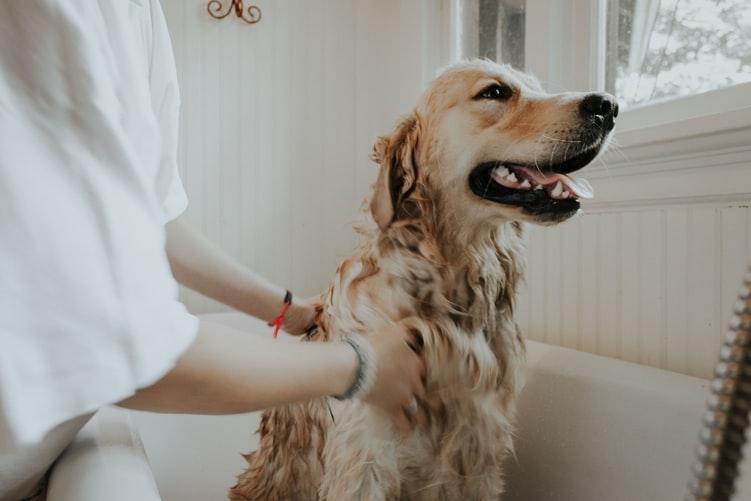Summary: Curious about how to clean your dog? In this blog, find 5 essential dog hygiene tips to keep your pup and home healthy… A clean dog is usually a healthy dog, which is what any good pet parent should want for their fur baby! But, good hygiene can take practice. Yes, wild dogs usually […]
- Home/
- Dog/
- Health & Wellness/
- Clean Dog: 5 Essential Dog Hygiene Tips For Pet Owners
Clean Dog: 5 Essential Dog Hygiene Tips For Pet Owners

Summary: Curious about how to clean your dog? In this blog, find 5 essential dog hygiene tips to keep your pup and home healthy…
A clean dog is usually a healthy dog, which is what any good pet parent should want for their fur baby! But, good hygiene can take practice.
Yes, wild dogs usually take care of their own hygiene, but because domesticated dogs are in contact and in close proximity with humans and other dogs more frequently, they need extra care and a higher standard of cleanliness to keep them safely in our homes. So, to be sure you have a clean dog – and thus a healthy one – it’s time to start following the 5 essential dog hygiene tips below…
Dog Hygiene
1. Wash Your Pet, Their Bedding & Toys Regularly
Your Dog
While there is no one-size-fits-all rule that applies to every single dog, it is generally advised that you should bathe your pup once every 12 weeks as a minimum. Although, if they’re prone to yeast overgrowth, or regularly find themselves getting muddy and dirty on walks, it’s perfectly safe to wash your dog up to once a week, provided that you’re using a gentle shampoo and you’re not overwashing them. This helps keep their fur and skin clean, and clear of dead skin cells and debris. Gently brushing them every day can also help dislodge unwanted grubby bits and distribute the naturally produced oils and healthy bacteria living on the skin down through and across their coat.
PetLab Co Pro Tip: You should also clean your doggo’s ears regularly. Some pups may even need daily ear cleaning! Ears can contain lots of yeast organisms that can breed and spread to other areas of the body, or cause an infection in the ear itself… Learn How To Clean Your Dog’s Ears here.
Their Bedding
Dog beds are a magnet for collecting dirt and fur, whilst also making an ideal home for flea eggs and larvae. Bedding should go through the washing machine at a minimum of 130°F with a gentle, fragrance-free detergent once a week and/or when noticeably dirty. Make sure the bedding is totally dry before allowing your dog to use it again.
Vacuuming your home regularly can also help with keeping your carpets and floors clean and parasite/hair-free. You should be vacuuming around the house at least once a week, and especially in the rooms that your dog has access to.
Their Toys
Your dog’s toys are usually carried in their mouth, meaning their cleanliness is paramount, otherwise the bacteria that builds up on them can enter your dog’s system and wreak havoc. To ensure safe, hygienic play, wash your dog’s soft toys in the washing machine at a minimum of 130°F with a gentle, fragrance-free detergent once a month.
For your hard non-absorbed non-porous dog toys, wash with a tiny bit of water-diluted bleach or soak them in half water, half vinegar solution for 30 minutes. It’s important to remember to rinse the toys properly after use of products like bleach, to ensure that your pup does not lick and ingest it. Beware of using anti-bacterial sprays – cleaning a toy with disinfectant sprays can harm or even potentially poison your dog.
2. Store Pet Food Correctly

Let’s be honest, dog food isn’t the nicest smelling, but when it’s exposed to heat, light, and air it can rapidly become rather rancid. It can also make your pup very sick! Would you eat food that’s been left out exposed overnight? Well… We can guess the answer to that!
Like human food, dry dog food can become contaminated with bacteria like Salmonella, which can also be transmitted to humans via a dog’s mouth. This can cause a very nasty period of sickness in humans so it’s really important to store food properly too and consider this, especially when feeding raw meats. Dry food should always be stored in airtight containers.
Canned meat, when opened, needs to be immediately covered or stored in an airtight container and refrigerated for up to 3 days. After this time period, it should be thrown away. You should also throw away any uneaten leftovers in your dog’s bowl after a few hours of it sitting in the dog bowl.
Raw foods can carry an even higher risk of bacterial imbalance and need to be used within 1-2 days after opening (or thawing from being frozen). If your dog’s raw food is frozen, it normally lasts for around 6 months in the freezer, but make sure it’s sealed and wrapped properly whilst in there.
Always follow the storage guidelines on the back of the dog food that you buy. This is the best place to understand specific storage conditions and spoilage dates for your particular food, to ensure your dog is being fed safely.
PetLab Co Pro Tip: Storing open food in the garage or outside? Stop! Open food outside will attract rodents which can contaminate your pup’s grub with feces and/or parasites, not to mention attracting them way too close to your home for anyone’s liking!
Read our Essential Guide On How To Store Dog Food Safely here, to keep your hygiene standards high when it comes to your dog’s food.
3. Wash Their Food Bowls
How often do you wash your dishes? After every meal, right? It’s a habit we’ve been accustomed to because it’s good for our hygiene and our health. But for some reason, the same emphasis hasn’t been put on our pets’ plates!
If you don’t wash your dog’s water and feeding bowls after each meal, you’re allowing bacteria to keep growing in the bowl, then that bacteria is going to get into their mouth, and eventually their system. Once it’s in the mouth, it has access to all the organs inside your dog’s body. And, just like our bodies, your dog’s insides will then be vulnerable to infections and diseases.
PetLab Co Pro Tip: A simple way to get around the trouble of cleaning your pooch’s bowl every single day is by having spare food and water bowls. If you have extra ones, you can wait a day or two to clean the already dirty ones. We know how busy life can be, especially as a pet parent! So, give yourself more flexibility by simply buying a few extras.
4. Get Diligent With Flea And Tick Prevention
Regular flea and worm control is an absolutely vital part of being a responsible pet parent and protecting both your dog and others they come into contact with. Dogs can pass on these pesky little parasites to humans, children and deposit their eggs around your house, and believe us when we say this – prevention is SO much easier than trying to remove these tiny bugs once they have established themselves in your home. So, if they’re not already receiving regular anti-parasitic treatments, it’s time to check in with your vet to get your beloved pet into the most suitable flea and parasite prevention routine.
Preventative treatments come in tablet form, injection (administered by the vet) or an oily substance applied to the back of their neck (which you can apply yourself) and usually is required every few weeks.
Fleas are absolutely no fun for both you and your pet to deal with and are also very unhygienic for your home to go through too.
5. Clean Their Teeth

Can you imagine not brushing your teeth every day between visits to the dentist? Well, dogs get plaque build-up just like we do, and can get very smelly breath, so they need to have their teeth brushed too!
Bacteria naturally settles on the teeth after every meal for both humans and animals, which can cause a build-up of plaque and tartar. If a dog’s teeth are not regularly cleaned, that tartar can lead to oral discomfort.
Be an excellent pet parent and try to brush your dog’s teeth two/three times a week with a dog enzymatic toothpaste and use dental mouthwash every day. Never use human toothpaste on dogs, as it may contain ingredients that are harmful to their digestion.
Our Final Thoughts On Keeping A Clean Dog
Clearly, keeping a clean dog means you’re more likely to keep a healthy dog and thus keep you and your family healthy as well. To further cut down the spread of disease and ill health, make sure that you and your household are regularly cleaning your hands too, particularly after petting, feeding, playing with, or cleaning up after your pup and definitely before and after handling yours and their food.
 S
S



